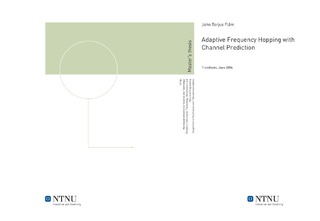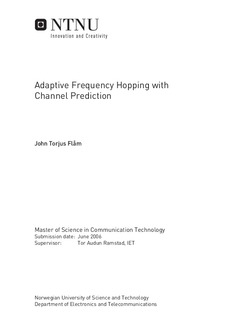| dc.description.abstract | The number of radio systems operating in the 2.4 GHz band is rising as a result of increased usage of wireless technologies. Since such devices interfere with one another, satisfactory co-existence becomes important. Several techniques serve to reduce the interference. Included among these are frequency hopping (FH) and power-control. This report focuses only on FH, and particularly on methods that make FH schemes adaptive. An FH scheme is adaptive if it responds to the noise and fading by avoiding channels that are unfit for transmission. An example of such a scheme is already implemented in an audio transceiver, the nRF24Z1, manufactured by Nordic Semiconductor. That transceiver provides the framework for this study, and the main objective is to suggest improvements to its FH algorithm. Better performance is particularly interesting in high quality audio streaming because such transmissions generally have strict real time requirements. Thus, the time to retransmit corrupted data is limited, and measures to reduce the impact of interference and fading are desired. The FH scheme implemented in the nRF24Z1 works broadly as follows: If a channel distorts more than a certain share of the transmitted data, it is extracted from the FH routine and listed as banned for usage. The ban list has room for maximum 18 out of 38 channels and can therefore filter out significant parts of the spectrum. If the system identifies more poor channels than the list can hold, the oldest channel in the ban list is released, and the newly identified one takes its place. In a scenario where noise and deep fades come to occupy a rather stable group of channels, the banned channels will match the unsuited parts of the spectrum quite accurately, and the scheme performs well. However, when the noise and fading is changing, maybe quickly and non-periodically, the performance drops significantly. The reason is that channels are banned only after they have caused trouble, which has two negative effects. Firstly, it is likely that the bulk of the transmitted data was distorted, and the need for retransmission can therefore be large. Secondly, since the transmission conditions are changing, the ban list becomes outdated and reflects the actual interference and fading poorly. Therefore, in this report, the possibility of predicting poor channels in order to avoid them beforehand, is investigated. For the purpose of prediction, small test packets are transmitted. In short, the principle of operation is that if a test packet is readable at the receiver, the channel is used. Otherwise it is avoided. Computer simulations indicate that this technique improves transmission conditions and reduces the need for retransmission when the noise and fading change significantly. Large changes are indeed common in practice. They occur, for example, if a broadband interferer is switched off or greatly varies its output power. Plainly, they could also come about when objects move. Despite promising simulations, channel testing does not come without side effects. An audio streaming system like the nRF24Z1 must secure a certain flow of data to avoid audible errors. If prediction algorithms are to secure that flow, a compromise must be made: the more time a system spends on channel testing, the less time remains for transmission of data. Therefore, at some point, testing must be terminated to leave room for the real job. In consequence, the key issue of finding the best trade-off between testing and transmission must be addressed. This report presents three adaptive FH schemes that approach that issue in their own manner. The performance of the proposed prediction schemes has been investigated using a channel model for the ISM band (Industrial, Medical, and Scientific). It is coded and developed in MATLAB. The model mimics the effects of a real mobile channel quite well, and this inspires non-negligible confidence in the simulation results. | nb_NO |

